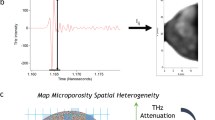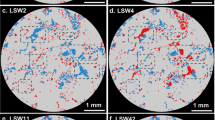Abstract
Carbonate reservoirs in the Middle East are believed to contain about half of the world's oil1. The processes of sedimentation and diagenesis produce in carbonate rocks microporous grains and a wide range of pore sizes, resulting in a complex spatial distribution of pores and pore connectivity2. This heterogeneity makes it difficult to determine by conventional techniques the characteristic pore-length scales, which control fluid transport properties. Here we present a bulk-measurement technique that is non-destructive and capable of extracting multiple length scales from carbonate rocks. The technique uses nuclear magnetic resonance to exploit the spatially varying magnetic field inside the pore space itself—a ‘fingerprint’ of the pore structure. We found three primary length scales (1–100 µm) in the Middle-East carbonate rocks and determined that the pores are well connected and spatially mixed. Such information is critical for reliably estimating the amount of capillary-bound water in the rock, which is important for efficient oil production. This method might also be used to complement other techniques3,4,5 for the study of shaly sand reservoirs and compartmentalization in cells and tissues.
This is a preview of subscription content, access via your institution
Access options
Subscribe to this journal
Receive 51 print issues and online access
$199.00 per year
only $3.90 per issue
Buy this article
- Purchase on Springer Link
- Instant access to full article PDF
Prices may be subject to local taxes which are calculated during checkout




Similar content being viewed by others
Notes
* This article has been corrected. On page 179 of this paper, the six occurrences of π2 on lines 10 and 23 of the text should have been π/2.
References
World Oil Trends (Arthur Andersen and Cambridge Energy Research Associates, 1997).
Tucker, M. E. Sedimentary Petrology 2nd edn (Blackwell, Oxford, 1991 ).
Wong, P. Z. (ed.) Methods in the Physics of Porous Media (Academic Press, London, 1999).
Kleinberg, R. L. in Encyclopedia of Nuclear Magnetic Resonance (eds Grant, D. M. & Harris, R. K.) Vol. 8, 4969 (Wiley, New York, 1996).
Kenyon, . E. Nuclear magnetic resonance as a petrophysical measurement. Nucl. Geophys. 6, 153–171 ( 1992).
Cory, D. G. & Garroway, A. N. Measurement of translational displacement probabilities by NMR: An indication of compartmentation. Magn. Reson. Med. 14, 435–444 (1990).
Callaghan, P. T., Coy, A., MacGowan, D., Packer, K. J. & Zelaya, F. O. Diffraction-like effects in NMR diffusion studies of fluids in porous solids. Nature 351, 467–469 (1991).
Cotts, R. M. NMR: Diffusion and diffraction. Nature 351, 443–444 (1991).
Barrall, G. A., Frydman, L. & Chingas, G. C. NMR diffraction and spatial statistics of stationary systems. Science 255, 714– 717 (1992).
Callaghan, P. T. Principles of Nuclear Magnetic Resonance Microscopy (Oxford Univ. Press, New York, 1993).
Hürlimann, M. D. Effective gradients in porous media due to susceptibility differences. J. Magn. Reson. 131, 232–240 (1998).
Weisskoff, R. M., Zuo, C. S., Boxerman, J. L. & Rosen, B. R. Microscopic susceptibility variation and transverse relaxation: Theory and experiment. Magn. Res. Med. 31, 601– 610 (1994).
Borgia, G. C., Brown, R. J. S. & Fantazzini, P. The effect of diffusion and susceptibility differences on T2 measurements for fluids in porous media and biological tissues. Magn. Res. Imaging 14, 731– 736 (1996).
Snaar, J. E. M. & Hills, B. P. Constant gradient stimulated echo studies of diffusion in porous materials at high spectrometer fields. Magn. Res. Imaging 15, 983– 992 (1997).
Hahn, E. L. Spin echoes. Phys. Rev. 80, 580– 594 (1950).
Torrey, H. C. Bloch equations with diffusion terms. Phys. Rev. 104 , 563–565 (1956).
Brownstein, K. R. & Tarr, C. E. Importance of classical diffusion in NMR studies of water in biological cells. Phys. Rev. A 19, 2446–2453 (1979).
Halperin, W. P., D'Orazio, F., Bhattacharja, S. & Tarczon, J. C. in Molecular Dynamics in Restricted Geometries (eds Klafter, J. & Drake, J. M.) Ch. 3 (Wiley, New York, 1989).
Latour, L. L., Mitra, P. P., Kleinberg, R. L. & Sotak, C. H. Time-dependent diffusion co-efficient of fluids in porous media as a probe of surface-to-volume ratio. J. Magn. Res. A 101, 342–346 (1993).
Acknowledgements
We thank M. D. Hürlimann for extensive discussions.
Author information
Authors and Affiliations
Corresponding author
Rights and permissions
About this article
Cite this article
Song, YQ., Ryu, S. & Sen, P. Determining multiple length scales in rocks. Nature 406, 178–181 (2000). https://doi.org/10.1038/35018057
Received:
Accepted:
Issue Date:
DOI: https://doi.org/10.1038/35018057
This article is cited by
-
Electrolyte contact changes nano-Li4Ti5O12 bulk properties via surface polarons
Communications Chemistry (2023)
-
Study on the pore structure and radon emission characteristics of typical rocks in the Lintong area
Bulletin of Engineering Geology and the Environment (2023)
-
From diffusion in compartmentalized media to non-Gaussian random walks
Scientific Reports (2021)
-
Machine learning assistive rapid, label-free molecular phenotyping of blood with two-dimensional NMR correlational spectroscopy
Communications Biology (2020)
-
A study on the flowability of gas displacing water in low-permeability coal reservoir based on NMR technology
Frontiers of Earth Science (2020)
Comments
By submitting a comment you agree to abide by our Terms and Community Guidelines. If you find something abusive or that does not comply with our terms or guidelines please flag it as inappropriate.



